Mask: Remove the mask / nasal pillows from the headgear. Clean with warm, soapy water. Rinse;
Tubing: Wash in warm soapy water, then rinse and air dry;
Humidifier: Empty the humidifier and let it air dry. Change the water in the humidifier.
Mask: Remove the mask / nasal pillows from the headgear. Clean with warm, soapy water. Rinse;
Tubing: Wash in warm soapy water, then rinse and air dry;
Humidifier: Empty the humidifier and let it air dry. Change the water in the humidifier.
Q:What is the difference between lithium rechargeable batteries and other rechargeable batteries?
A:First of all, this product belongs to the “polymer lithium ion battery,” namely “lithium battery “. Whereas the “rechargeable battery” refers to nickel-metal hydride or nickel-cadmium batteries, which are fundamentally different. Compared with NiMH or NiCd batteries, the lithium battery has such characteristics as high energy density, long cycle life, no memory effect, quick charging speed, ultra-low self-discharge, light weight and environment-friendly. In other word, the phone battery we use now is basically the lithium battery, which is well understood. The phone battery is also developed from nickel-cadmium and nickel hydrogen batteries. “Lithium battery” represents the best battery energy technology at present.
Q:Before that, is there no AA or AAA rechargeable lithium battery?
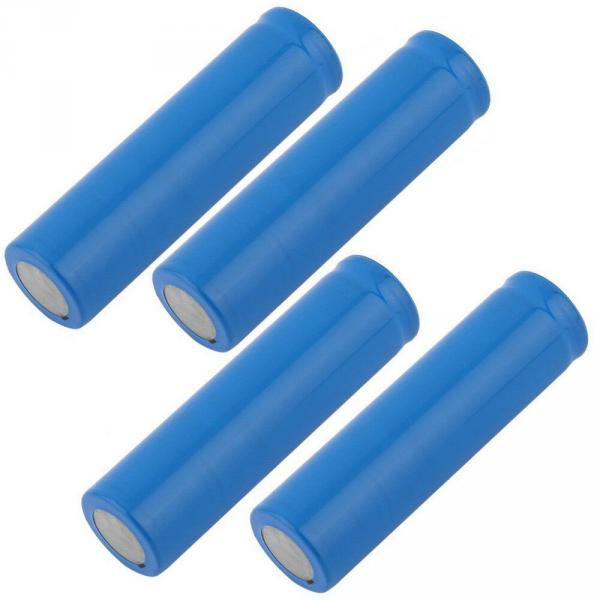
A:All along, AA or AAA batteries have no lithium batteries in real sense, mainly because the electronic devices on the market using standardized batteries are all designed based on the voltage characteristics of dry batteries (Single voltage of 1.5V). Compared to the traditional standardized batteries, lithium-ion battery’s output voltage is higher (Single voltage of 3.7V). This unique chemical characteristic makes it, the best contemporary energy, have not been possible to enter this field, resulting in serious deficiencies of lithium-ion rechargeable battery in the application field of standardized cylindrical battery.
Q:How can Lithium Polymer Battery be in common use?
A:The 1.5V universal polymer lithium-ion batteries are the major research after years of exploration and research in seeking optimal power solution to portable electronics. It adopts the voltage conversion technology, converting the output voltage of 3.7V into 1.5V, which is fully compatible and alternative to traditional batteries. It has completed a great creation in the field of traditional standard batteries, making the lithium battery step forward to be universal.
Q:What is the difference between polymer lithium ion battery and ordinary lithium ion battery?
A:According to different electrolyte materials, lithium-ion batteries can be divided into polymer lithium ion battery (PLIB), and Li-ion battery (LIB). Ordinary lithium-ion battery refers to liquid lithium battery. In contrast, polymer lithium-ion battery has such characteristics as high energy density and good safety performance. Its quality increases by 20% compared with ordinary lithium-ion (liquid) battery.
Q:How long does it take to charge batteries?
A:It takes about 3 hours to fully charge AA battery and about 2 hours to fully charge AAA battery.
Tips: Due to the special charging characteristics of lithium battery, when the charging time reaches half of the entire charge cycle, the battery has reached more than 85% of the full electric quantity. So in the case of emergencies, it just need half the charging time, thus saving your valuable time.
Q:What does the dual voltage of 1.5V / 3.7V on the battery label mean?
A:There are two sets of output voltage on the positive electrode of lithium batteries. The protruding one of 1.5V is universal battery voltage, users can use it normally, and the other is 3.7V in the groove, which is used to charge the battery.
Q:Why the product is marked of mWh rather than mAh?
A:mWh represents “milliwatt hour”, on behalf of the battery capacity. It is labelled in accordance with the new labeling specifications of lithium-ion batteries. mWh = mAh * voltage.
Q:What is the difference between lithium iron phosphate battery and universal polymer lithium battery?
A:The differences lie in:
1) Voltage: the voltage of lithium iron phosphate battery is 3.2 V. When fully charged, its actual voltage is 3.6 V or so. Such a high voltage is beyond the limit voltage of the appliances using AA or AAA universal battery. So it is easy to damage the appliances (note: this is why the businessman has repeatedly remind users that the battery fully charged should be placed more than 1 hour until the voltage drop, then they can use); universal lithium battery uses intelligent voltage transformation technology, with the constant voltage output voltage of 1.5 V, to ensure the standard voltage of the appliances. (You can check the input voltage parameters on the labels of electrical appliances) Note: the use of this product is like the use of ordinary dry batteries, don’t need to add another bit bucket!
2) Security: Strictly speaking, lithium iron phosphate battery cannot be considered as “batteries”, it is just a cell, without protection circuit; uinversal lithium battery uses multiple intelligence protection circuit preventing overcharge, over discharge, short circuit, overheating, very safe to use. This is also a reason why the cost of the product is higher. Note: lithium iron phosphate battery, because of no protection circuit, have been over discharged when many electrical equipment reach the lowest limit voltage. This is why businesses repeatedly remind users that: Do not charge the battery until it is completely discharged!
3) Capacity: generally, the highest capacity of lithium iron phosphate battery is 600mAh. Its nominal voltage is 3.2V, to be used with bit bucket. Take the electrical equipment using two AA batteries for example. Lithium iron phosphate battery: 600mAh * 3.2V * 1 = 1920mWh; Battery: 760mAh * 3.7V * 2 = 5624mWh; it can be seen that the capacity of lithium batteries is nearly three times that of lithium iron phosphate in the practical application.
Q:What is the concept of the product compared with the ordinary disposable batteries?
A:The product uses polymer lithium cells, which can be recycled 500 to 1000 times. The full charged electricity once is equivalent to that of 2 to 5 batteries. It is no exaggeration to say that a universal lithium battery is equivalent to 1000 to 1500 alkaline batteries, 5000 to 6000 ordinary KK batteries. That’s economical and environment-friendly.
Q:Can we charge other common rechargeable batteries with the special lithium battery’s charger? Or charge universal lithium batteries with ordinary NiMH battery’s charger?
A:No, you can’t! Because charging voltage is different, lithium battery charger is much more complex.
Q:How many mAh is the AA/PH5 battery of 2800 mWh equivalent to?
A:As this is a lithium polymer battery with nominal voltage of 3.7V, and batteries capacity of 760 mAh, when the voltage is converted into the output voltage of 1.5V, it will be more accurate to calculate in “mWh” (power) according to the latest national labelling standard. But compared with the nickel-metal hydride battery, when 1.2 V is divided by 2800 mWh, it is equivalent to more than 2330 mAh. But because the universal lithium is a constant voltage output, the efficient capacity can be released completely, so the stronger battery life of devices using larger electricity reflecting is several times stronger than that of the nickel-metal hydride batteries, or even ten times more.
Q:Is the battery safe?
A:It is very safe, because there are multiple protection mechanism inside the battery. If the voltage conversion circuit is damaged, protection circuit will truncate the output, and the output voltage will be zero.
Q:How about the 1.5 V AA rechargeable lithium battery?
A:Batteries of the AA / AAA rechargeable lithium ion are the best on the universal batteries market, according to the “best” does not mean that the battery manufacturing technology so mystical, but the materials inside the battery – “cells” are changed, used polymer lithium ion cells, while the polymer lithium ion represents the contemporary the most optimal battery technology, so we said the battery is the “best”. , of course, the “best” is relative, lithium batteries due to a high energy, no memory effect, long cycle life, light weight and fast charging itself unique performance advantage has become the mainstream of the current battery power, and all of these “performance advantages of lithium battery is also relative to Ni-MH batteries, we have seen, in the high-end electronic products market is almost can not see the figure of Ni-MH batteries, replaced by lithium batteries; And in the field of general battery, namely we are the most common AA /AAA standard battery system development has been to stay in “nickel metal hydride phase,” battery is precisely at this time, apply a “voltage transformation technology” to “introduction” general batteries, lithium-ion batteries for contemporary general battery and battery technology “synchronous”. We can imagine, with the development of science and technology, technology updates, there may be a fuel cell in the future, better batteries energy sources such as nuclear power battery, but in the present stage of batteries, lithium batteries will occupy the mainstream market in a long time.
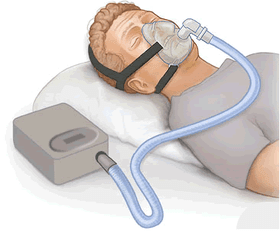
CPAP, or continuous positive airway pressure, is a treatment that uses mild air pressure to keep the airways open. When a person sleeps, the muscles of the entire body relaxes. This includes the upper airway muscles surrounding the throat. These muscles may relax enough to collapse on the airway causing an obstruction of oxygen into the lungs and carbon dioxide out of the lungs; This is called obstructive sleep apnea (OSA). CPAP helps to prevent this collapse by pushing air into the throat creating an air stent. Once the airway is open, the person will be able breathe easily as he/she sleeps.
CPAP treatment involves a CPAP machine, which has three main parts:
Some CPAP machines have other features as well, such as heated humidifiers. CPAP machines can be small. They are also lightweight and fairly quiet.
CPAP is often the best treatment for obstructive sleep apnea. Sleep apnea is a common disorder that causes pauses in breathing or shallow breaths while you sleep. As a result, not enough oxygen reaches your lungs.
In obstructive sleep apnea, your airway collapses or is blocked during sleep. When you try to breathe, any air that squeezes past the blockage can cause loud snoring. Your snoring may wake other people in the house.
The mild pressure from CPAP can prevent your airway from collapsing or becoming blocked.
The animation below shows how CPAP works to treat sleep apnea. Click the “start” button to play the animation. Written and spoken explanations are provided with each frame. Use the buttons in the lower right corner to pause, restart, or replay the animation, or use the scroll bar below the buttons to move through the frames.
If your doctor prescribes CPAP, you’ll work with someone from a home equipment provider to select a CPAP machine. Home equipment providers sometimes are called durable medical equipment, or DME.
Your doctor will work with you to make sure the settings that he or she prescribes for your CPAP machine are correct. He or she may recommend an overnight sleep study to find the correct settings for you. Your doctor will want to make sure the air pressure from the machine is just enough to keep your airway open while you sleep.
There are many kinds of CPAP machines and masks. Let your home medical provider know if you’re not happy with the type you’re using. He or she may suggest switching to a different type that might work better for you.
CPAP has many benefits. It can:
Many people who use CPAP report feel more energetic once they begin treatment. They’re more attentive and better able to work during the day. They also report fewer complaints from bed partners about snoring and sleep disruption.
The Soeks Ecovisor F4 is a handy device to have at home which carries out 4 important environmental tests. Namely: nitrate tester, dosimeter, EMF & water quality tester. The device is compact and easy to use. It features an intuitive touchscreen. To turn it on, you press and hold the OK button until it lights up. There is no setting up of any kind required, this device is ready to use straight out of the box.



SOEKS EcoVisor F4 performs express analysis of nitrate content in fresh fruit and vegetables. Nitrate content analysis is based on conductivity of alternating high-frequency current in the measured product (ionometry).

SOEKS EcoVisor F4 defines radiation background level and identifies radioactive contaminated foods and construction supplies. The Ecotester can easily assess the level of radioactivity according to the power level of ion radiation (gamma radiation and beta particles flux).

SOEKS EcoVisor F4 records the electromagnetic field in facilities, living areas and from domestic appliances. When electromagnetic fields are detecting, electric and magnetic field intensities evaluate.

SOEKS EcoVisor F4 evaluates water quality. The analysis is based on measurement of high-frequency alternating current conductivity.
| Name of specification | Indication |
| Nitrate Tester – Nitrate measurement | |
| Scale range of possible nitrate content, mg/kg | from 20 to 5 000 |
| Temperature compensating, °С | From 0 to 30 |
| Measurement uncertainty, max | ± 12% |
| Dosimeter – Radiation measurement | |
| Measurement units | Sievert Roentgen |
| Scale range of possible radiation background, mSv/h | up to 1 000 |
| Scale range of possible radiation background, mR/h | up to 100 000 |
| Registered gamma ray energy, eV | from 0.1 |
| Warning thresholds, mSv/h (mR/h) | From 0.1 to 100 (from 10 to 10 000) |
| Warning threshold of accumulated dose, Sv (R) | From 0.1 x 10-6 to 1 (from 10 x 10-6 to 100) |
| Time of accumulated dose, days | Up to 1 000 |
| EMF meter – Electromagnetic Field measurement | |
| Scale range of electric field frequency, hz | From 20 to 2000 |
| Scale range of magnetic field (magnetic induction) intensity crest value, A/m (meTl) | From 0.08 to 20 (from 0.10 to 25) |
| Max. permissible relative measurement uncertainty of magnetic field intensity, % | ± 18% |
| Scale range of magnetic field intensity crest value, V/m | From 10 to 5000 |
| Max. permissible relative measurement uncertainty for electric field, % | ± 18% |
| TDS meter – Water quality measurement | |
| Scale range ppm (mg/l) | Up to 5000 |
| Resolution ppm (mg/l) | 10 |
| Temperature compensating, °С | From 0 to 30 |
| Measurement uncertainty, from full scale, % | ± 12% |
| General specifications | |
| Operating time including hibernation, hours | Up to 24 |
| Power supply | 2 of AAA batteries or accumulators |
| Power supply range, V | 2.0 – 3.5 |
| Overall dimensions Height x Width x Thickness, max, mm | 147 x 54 x 21 |
| Device mass (with power supply) , max, grs | 95 |
| Battery charging current, max, mA | 300 |
| Current from power supply or USB , max, mA | 500 |
| Charger output voltage, V | From 4.5 to 5.5 |
| Display | Color touchscreen TFT 320 x 240 |
| Operating temperatures range, °С | From -20 to +60 |
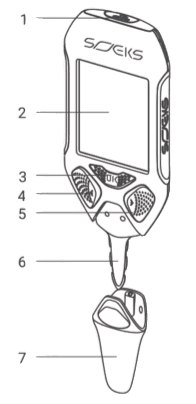
1. Micro USB slot for charging the accumulator.
2. Touchscreen for displaying information and menu navigation.
3. OK button for switching the device on/off, confirmation button.
4. LEFT button for menu navigation, return to previous menu when pressing for 2 seconds.
5. RIGHT button – menu navigation.
6. Measuring probe inserts in the product to measure nitrate content level.
7. Protective cap protects the probe.
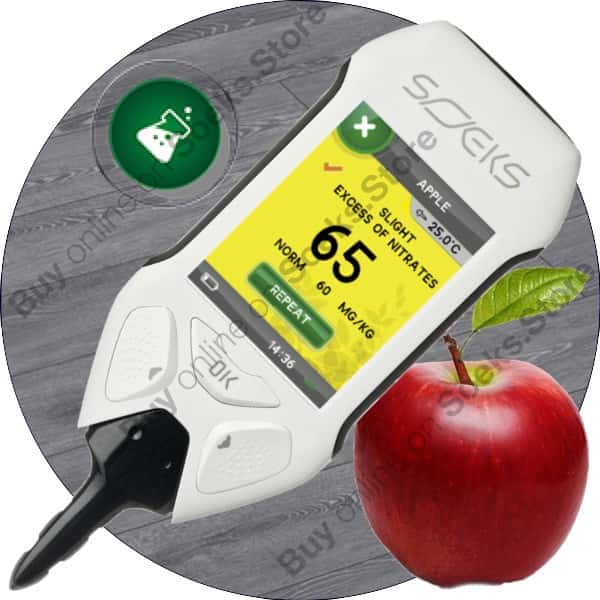
Measurement of nitrate content level is based on the patented technology of a biobased product ionometry (Patent of invention № 23 90 767 Ionometry Method for biobased products and the device for its performance) and has been developed by the SOEKS company.
The technology is based on a specialized procedure method that puts high-frequency electric current through pulp.
Every plant contains ions of potassium, magnesium, ferrum (iron), cuprum, chlorine, plenty of organic acids and other elements in certain amounts that are necessary for proper growth.
The amount of every single element (ionic or molecular) is determined by bio organics of certain plant (it has a basic level of ion concentration) and by contents of water and soil where the plant grows.
People often use fertilization for efficient growth of plants. For instance, saline fertilizers such as nitrates and phosphates. As they break down and the plant easily absorbs these fertilizers.
As it spreads around the plant, saline ions (nitrates, phosphates and etc.) accumulate in different plant parts including fruits. This leads to higher amount of electrolytes and to higher electrical conductivity of fruit as well.
SOEKS EcoVisor F4 has mastered the measurement of nitrate ions content in fruits and vegetables. A percentage of these in fruit and vegetables is identified by an independent analysis method (potentiometric identification of nitrate content according to Russian National Standard (GOST) “Fruit and vegetables recycling products. Nitrate content identification”).
The result of express analysis is shown by the device in the form of nitrate ion concentration and its comparison to maximum permissible concentration for certain product. The device measures the nitrate concentration per kilogram of product netto. 200-300 mg of nitrates eaten within 24 hours is considered to be safe for an adult. If 600-700 mg is eaten within 24 hours, nitrates are considered toxic.
For instance, when measuring a beetroot, the device shows 1000 mg of nitrates per kg. According to the standard measurement, it is safe to only eat 200-300 mg of this beetroot without damaging your health.
When measuring a watermelon, the device shows 350 mg/kg. If a person eats 2 kg of watermelon, he or she will consume 700 mg (350 mg/kg x 2 kg) which is toxic.
One should also understand that the shown result is evaluative and cannot be compared to quantified chemical analysis at an advanced laboratory. That kind of analysis requires a lot of time and is not free. Nevertheless, the presence of such laboratory and qualified analytical chemist at home is impossible for the majority of people. The EcoVisor F4 is a like portable lab that allows you to avoid buying suspicious products. This will help protect yourself, your relatives and children from being exposed to these poisonous products.
The nitrate tester analysis takes only a few seconds. The only maintenance it requires is to change the battery or charge the accumulator just as you would your mobile phone.
Of course, you may ask yourself is there an increased electrical conductivity if a fruit or vegetable does not contain nitrate ions? This is possible. But will the consumer feel safer buying a product with increased amount of phosphates or any other ions instead of nitrates or when buying a product that is already going bad? One should not forget that basic electrical conductivity is determined for every single type of fresh fruit or vegetable. When a product goes bad, the content and concentration of organic acids change.
ATTENTION! We strongly do not recommend to measure nitrate content in liquids, chemically and heat-treated products, products that are not included in the device’s menu list. Received data will be misleading and uncertain.
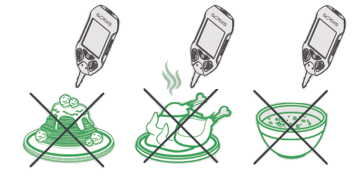
One should also remember that the device is designed for measuring products at a room temperature. Change of the product temperature can increase measurement uncertainty. This regards to products that have just been taken out of fridge or have been exposed to sun rays. In SOEKS EcoVisor F4 there is a function of thermal compensation, which is achieved by means of embedded temperature gauge in probe of the device. Thanks to software patches, when measuring you can get the same measurement result even when temperatures of measured products are different.
There are fruit and vegetables in the list of Nitrate tester, which contain air cavities (for instance, sweet pepper). When measuring such products, it is important not to insert the probe into the air cavity. When the probe is inserted into the air cavity, the measurement result will be misleading.
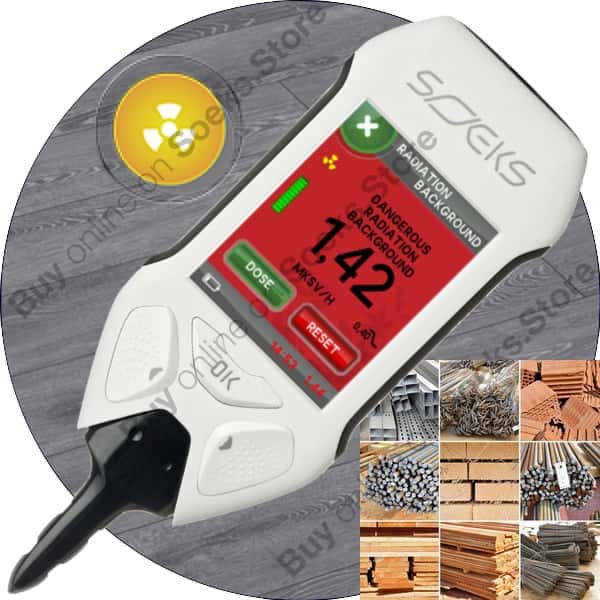
Some chemical elements (so called radioactive isotopes) contain unstable nucleus that decay into small elementary particles or quanta. Detachment of elementary particles or quanta is called radiation.
Radiation is ionizing, because it leads to atomic ionization of substance that is struck by radiation. Ionization is called the process of striking one or a few electrons out of atom. After that, nucleus and left electrons create a system that is positively charged and is called an ion.
Ionized atoms strongly differ from average nucleus. Ions destroy other molecules by breaking a bond between nucleuses. That is the reason why ionized radiation influence on human’s health is harmful.
Radiation influence on the human body is called irradiation. Irradiation transpierces any body tissues and ionizes their particles and molecules. This leads to creation of ionized nucleuses (ions or so-called free radicals) that destroy molecules and lead to inclusive death of tissue cells.
As it was said before, nuclear disintegration into elementary particles is accompanied by radiation of these particles. This radiation is divided into following types:
X-rays are electromagnetic radiation (just like gamma decay) but it has less energy. In everyday life, it is used only at medical institutions.
Neutron radiation is an uncharged particle streams (neutrons). It occurs only in nuclear reactors.
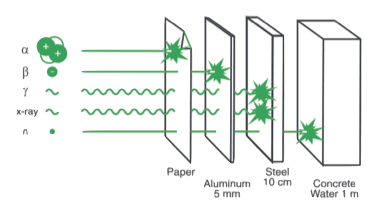
Modern domestic dosimeters measure radiation in micro Sieverts per hour (mSv/h) and micro roentgen per hour (mcR/h).
The radiation dose absorbed by human’s body is measured in micro Sieverts and the radiation dose in the air at measurement spot is measured in micro roentgen.
To estimate the radiation influence on the human body, the concept of equivalent dose is used. Equivalent dose is an amount of energy absorbed by mass unit of biological tissue considering biological danger of this radiation type. The unit of measurement for equivalent dose is the Sievert (Sv).
To estimate the influence of gamma decay which are the most absorbed radiation type and give most impute to human exposure, the concept of air radiation dose is used. It has its own unit of measurement – roentgen (R).
There is no natural radiation background standard because radiation background depends on the region, district and amount of radioactive particles that are found in objects around. For instance, radiation background at highlands is always higher than at low land.
SOEKS EcoVisor F4 measures radiation in micro Sieverts per hour (mSv/h) and micro roentgen (mcR/h), where 0.01 mSv/h corresponds to 1 mcR/h according to biological radiation effect.
Natural radiation background usually ranges from 0.08 mSv/h till 0.18 mSv/h. Safe radiation background level for a human is considered to be up to 0.4 mSv/h (the 0.4 mSv/h exposure per hour).
When Level of Radiation is exceeded (more than 0.4 mSv/h), the recommended time of staying in an irradiation area is regressive. The Radiation Level amounts to 0.4 mSv/h, you can stay in the irradiation area for one hour. If the Radiation Level amounts to 0.8 mSv/h, you can stay in irradiation area for half an hour. Duration of stay in area with 1.6 mSv/h radiation amounts shouldn’t exceed 15 minutes and so on.
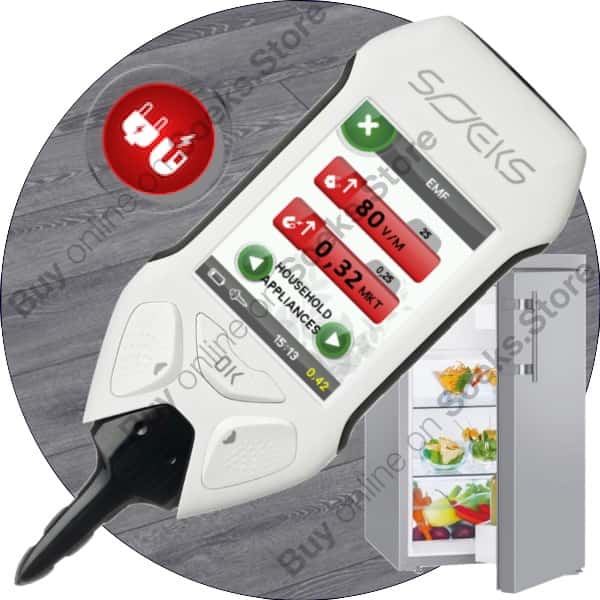
Electromagnetic field (EM field) is a special form of matter which measures the interaction of charged particles. It represents interrelated alternating electric and magnetic fields. EM field spreads from one space point to another in form of electromagnetic progressive waves running from source.
EM field is created of particle charges. For example, in physics, students do experiments with ebonite electrification to demonstrate the electric field.
Magnetic field is created when electrical charges move through a conductor.
In order to characterize electric field strength, we use “electric field intensity” definition (mark sign – E, measurement unit – V/m (Volt per meter)). Magnetic strength is characterized by N magnetic field strength, measurement unit – A/m (Ampere per meter). When measuring very low and extremely low frequency, “magnetic density” definition is often used (mark sign – V, measurement unit – Tl (Tesla)).
Experimental Data of Russian and foreign research show that electromagnetic fields are highly bioactive and can negatively affect our health.
Many researches of EM field’s biological effect allow us to detect the most susceptible body systems: nervous, immune, endocrine and reproductive systems. These body systems are critical in our daily function.
EM fields influence water rich body organs mostly which are the eyes, brain, stomach and kidneys.
The following are symptoms of high EM field exposure can cause fatigue, irritability, sleep disorders, memory impairment and lack of attention.
The biological effect of EM fields tends to accumulate and can consequentially cause the degenerative process of the central nervous system, blood cancer (leukemia), encephaloma and endocrine system.
EM fields are especially dangerous for children, pregnant women, people with disorders of central nervous, the endocrine or cardiovascular system, allergic individuals and people with a compromised immune system.
Research has shown that the nervous system of the human body is the most sensitive to EM fields. When affected, it can cause serious malfunctions at the neuronal level, neural synapse and isolated neural structures. People who are in contact with electromagnetic fields, eventually face memory and higher nervous activity disorders.
Nowadays it is experimentally proven that electromagnetic fields negatively affect immunologic reactivity of body. Research data points to the fact that immunogenesis processes are violated and suppressed when being affected by electromagnetic fields.
When being affected by electromagnetic fields, changes in the pituitary adrenal system may occur. When being affected by electromagnetic fields, pituitary adrenal system is stimulated and therefore the amount of adrenalin in the blood rises and can trigger blood clotting. It is acknowledged that hypothalamus – pituitary – adrenal cortex system reacts on environmental interaction immediately and consistently.
Reproductive system disorders are usually connected with changes in its regulation within the nervous and neuroendocrine systems. This has been shown in research concerning the pituitary gonadotropic activity condition as it is affected by electromagnetic fields. Continuous EM field irradiation leads to lower pituitary activity.
Many scientists refer EM fields to teratogens that influence women’s health during pregnancy and fetus development. It is thought that electromagnetic fields can, for example, lead to physical defects of fetus. The fetus is very vulnerable at infancy during period of implantation and early organogenesis.
It is proven that fetus sensitivity to EM field is notably higher in mothers and may cause damage during it’s development. Results of epidemiological studies allow us to estimate that pregnant women who are in contact with electromagnetic field might suffer from premature birth. It might negatively affect fetus development and even cause congenital malfunctions of fetus.
Electric field strength of 50 Hz commercial frequency in facilities (at 0.2 m distance from windows and walls, 0.5-1.8 m high from floor) should not exceed 500 V/m (kilovolt per meter).
Magnetic field strength of 50 Hz commercial frequency in facilities (at 0.2 m distance from windows and walls, 0.5-1.5 m high from floor) should not exceed 10 mcTl (microtesla).
Electric and magnetic fields of 50 Hz commercial frequency can be evaluated when domestic appliances are turned off and local lighting is turned on. The electric field is evaluated when ambient lighting is off and magnetic field is evaluated when ambient lighting is on.
The electrical field of 50 Hz commercial frequency from overhead transmission lines and other objects on the territory of residential constructions should not exceed 1 kV/m (kilovolt per meter) 1.8 m high from ground.
The magnetic field strength of 50 Hz commercial frequency from overhead transmission lines and other objects on the territory of residential constructions should not exceed 25 mcTl (microtesla) 1.8 m high from ground.
In home, domestic appliances are sources of electromagnetic exposure. A person should evaluate their effect at a distance 10 ± 0.1 cm while standing in front, behind and next to the object (except TV).
Electromagnetic field from TV with a diagonal less than 51 cm (20”) is measured at a distance of 50 ± 1 cm in front, behind and next to the TV. When screen diagonal is more than 51 cm, the EM field is measured the same way at a distance of 100 ± 1 cm. The device must be preliminarily turned on and work at least 20 minutes before measuring.
The electrical field strength from PC ranging from 5 Hz to 2000 Hz should not exceed 25 V/m (volt per meter). The magnetic flux density from a PC ranging from 5 Hz to 2 KHz should not exceed 0.25 mcTl (microtesla).
Electromagnetic field is measured at 50 cm distance from the screen.
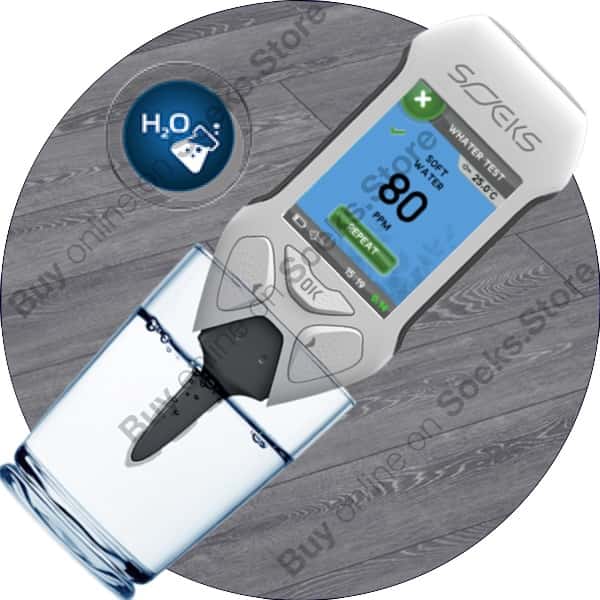
Water quality measurement is intended for quality evaluation of drinking water, as well as of water from treatment systems such as hydroponics, fish tanks, swimming pools, domestic appliances and from water wells.
The device measures the amount of solid particles that have been dissolved in water (TDS- total dissolved solids) per 1 million water particles – ppm (parts per million).
Among water particles, there is an enormous amount of dissolved water impurities in it. The main impurities are both inorganic salts (such as chlorides, sulfate bicarbonate of calcium, sodium, magnesium, potassium) and a small amount of organic substances.
The amount of dissolved in water solid particles depends on natural environment and varies from region to region. In the city, water content is influenced by it’s industrial drainage, rainfall drainage, chlorination etc.
Solids dissolved in water determine our water quality and can affect our bodily functions.
Potassium and magnesium salts affect water hardness. High levels of these elements can worsen the water’s taste, smell, muddiness etc. Hard water negatively affects digestive system, hair and skin when we shower. It can also cause kidney diseases.
With the help of EcoVisor F4 now, it is possible to determine whether the water is suitable for drinking, domestic needs or if it requires purification.
EcoVisor F4 can be used for evaluation of water filter efficiency. In addition, EcoVisor F4 is used for reverse osmosis filter. Such filters have a few filtration levels. One of them is represented by reverse-osmosis membrane which stops water impurities that cannot be stopped by other filters. This membrane’s service life period depends on amount of impurities in stream water. If the membrane clogs, it can lead to its mechanical damage and the whole filtration system can break down.
EcoVisor F4 can measure the amount of solid particles entering and exiting the filtration system and record its indication. If the amount of salts when exiting has increased, it is time to wash and change the membrane.
In addition, EcoVisor F4 is used in aquaristics. The device can pick water with necessary amount of solids.
Moreover, EcoVisor F4 can be used when watering plants and flowers. Harsh water can negatively affect plants because it increases concentration of lime in the ground. As the result, the ground becomes alkaline and blocks the nutrition for the plants.
Water with high amount of solids is harmful for domestic appliances (washing machines, coffee machines, and irons with steam generator, kettles, dishwashers and boilers). In all of these devices, there is a heating spiral. The scale on the heating spiral can overheat and breakdown. The EcoVisor F4 can help to evaluate quality of water in domestic appliances and take precautions when using it in the future.
Leading neuroscientist Matthew Walker explains why sleep deprivation is increasing our risk of cancer, heart attack and Alzheimer’s – and what you can do about it.
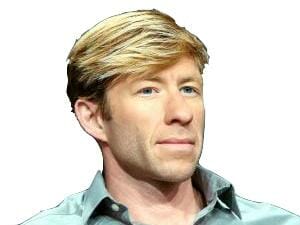
Matthew Walker has learned to dread the question “What do you do?” At parties, it signals the end of his evening; thereafter, his new acquaintance will inevitably cling to him like ivy. On an aeroplane, it usually means that while everyone else watches movies or reads a thriller, he will find himself running an hours-long salon for the benefit of passengers and crew alike. “I’ve begun to lie,” he says. “Seriously. I just tell people I’m a dolphin trainer. It’s better for everyone.”
Walker is a sleep scientist. To be specific, he is the director of the Center for Human Sleep Science at the University of California, Berkeley, a research institute whose goal – possibly unachievable – is to understand everything about sleep’s impact on us, from birth to death, in sickness and health. No wonder, then, that people long for his counsel. As the line between work and leisure grows ever more blurred, it is rare to meet a person who doesn’t worry about their sleep. But even as we contemplate the shadows beneath our eyes, most of us don’t know the half of it – and perhaps this is the real reason he has stopped telling strangers how he makes his living. When Walker talks about sleep, he can’t in all conscience, limit himself to whispering comforting nothings about camomile tea and warm baths. It’s his conviction that we are in the midst of a “catastrophic sleep-loss epidemic”, the consequences of which are far graver than any of us could imagine. This situation, he believes, is only likely to change if government gets involved.
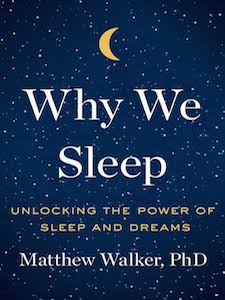
Walker has spent the last four and a half years writing Why We Sleep, a complex but urgent book that examines the effects of this epidemic close up, the idea being that once people know of the powerful links between sleep loss and, among other things, Alzheimer’s disease, cancer, diabetes, obesity and poor mental health, they will try harder to get the recommended eight hours a night (sleep deprivation, amazing as this may sound to Donald Trump types, constitutes anything less than seven hours). But, in the end, the individual can achieve only so much. Walker wants major institutions and law-makers to take up his ideas, too. “No aspect of our biology is left unscathed by sleep deprivation,” he says. “It sinks down into every possible nook and cranny. And yet no one is doing anything about it. Things have to change: in the workplace and our communities, our homes and families. But when did you ever see an NHS poster urging sleep on people? When did a doctor prescribe, not sleeping pills, but sleep itself? It needs to be prioritised, even incentivised. Sleep loss costs the UK economy over £30bn a year in lost revenue, or 2% of GDP. I could double the NHS budget if only they would institute policies to mandate or powerfully encourage sleep.”
Why, exactly, are we so sleep-deprived? What has happened over the course of the last 75 years? In 1942, less than 8% of the population was trying to survive on six hours or less sleep a night; in 2017, almost one in two people is. The reasons are seemingly obvious. “First, we electrified the night,” Walker says. “Light is a profound degrader of our sleep. Second, there is the issue of work: not only the porous borders between when you start and finish, but longer commuter times, too. No one wants to give up time with their family or entertainment, so they give up sleep instead. And anxiety plays a part. We’re a lonelier, more depressed society. Alcohol and caffeine are more widely available. All these are the enemies of sleep.”
But Walker believes, too, that in the developed world sleep is strongly associated with weakness, even shame. “We have stigmatised sleep with the label of laziness. We want to seem busy, and one way we express that is by proclaiming how little sleep we’re getting. It’s a badge of honour. When I give lectures, people will wait behind until there is no one around and then tell me quietly: ‘I seem to be one of those people who need eight or nine hours’ sleep.’ It’s embarrassing to say it in public. They would rather wait 45 minutes for the confessional. They’re convinced that they’re abnormal, and why wouldn’t they be? We chastise people for sleeping what are, after all, only sufficient amounts. We think of them as slothful. No one would look at an infant baby asleep, and say ‘What a lazy baby!’ We know sleeping is non-negotiable for a baby. But that notion is quickly abandoned [as we grow up]. Humans are the only species that deliberately deprive themselves of sleep for no apparent reason.” In case you’re wondering, the number of people who can survive on five hours of sleep or less without any impairment, expressed as a percent of the population and rounded to a whole number, is zero.
The world of sleep science is still relatively small. But it is growing exponentially, thanks both to demand (the multifarious and growing pressures caused by the epidemic) and to new technology (such as electrical and magnetic brain stimulators), which enables researchers to have what Walker describes as “VIP access” to the sleeping brain. Walker, who is 44 and was born in Liverpool, has been in the field for more than 20 years, having published his first research paper at the age of just 21. “I would love to tell you that I was fascinated by conscious states from childhood,” he says. “But in truth, it was accidental.” He started out studying for a medical degree in Nottingham. But having discovered that doctoring wasn’t for him – he was more enthralled by questions than by answers – he switched to neuroscience, and after graduation, began a PhD in neurophysiology supported by the Medical Research Council. It was while working on this that he stumbled into the realm of sleep.
“I was looking at the brainwave patterns of people with different forms of dementia, but I was failing miserably at finding any difference between them,” he recalls now. One night, however, he read a scientific paper that changed everything. It described which parts of the brain were being attacked by these different types of dementia: “Some were attacking parts of the brain that had to do with controlled sleep, while other types left those sleep centres unaffected. I realised my mistake. I had been measuring the brainwave activity of my patients while they were awake, when I should have been doing so while they were asleep.” Over the next six months, Walker taught himself how to set up a sleep laboratory and, sure enough, the recordings he made in it subsequently spoke loudly of a clear difference between patients. Sleep, it seemed, could be a new early diagnostic litmus test for different subtypes of dementia.
After this, sleep became his obsession. “Only then did I ask: what is this thing called sleep, and what does it do? I was always curious, annoyingly so, but when I started to read about sleep, I would look up and hours would have gone by. No one could answer the simple question: why do we sleep? That seemed to me to be the greatest scientific mystery. I was going to attack it, and I was going to do that in two years. But I was naive. I didn’t realise that some of the greatest scientific minds had been trying to do the same thing for their entire careers. That was two decades ago, and I’m still cracking away.” After gaining his doctorate, he moved to the US. Formerly a professor of psychiatry at Harvard Medical School, he is now professor of neuroscience and psychology at the University of California.
Does his obsession extend to the bedroom? Does he take his own advice when it comes to sleep? “Yes. I give myself a non-negotiable eight-hour sleep opportunity every night, and I keep very regular hours: if there is one thing I tell people, it’s to go to bed and to wake up at the same time every day, no matter what. I take my sleep incredibly seriously because I have seen the evidence. Once you know that after just one night of only four or five hours’ sleep, your natural killer cells – the ones that attack the cancer cells that appear in your body every day – drop by 70%, or that a lack of sleep is linked to cancer of the bowel, prostate and breast, or even just that the World Health Organisation has classed any form of night-time shift work as a probable carcinogen, how could you do anything else?”
There is, however, a sting in the tale. Should his eyelids fail to close, Walker admits that he can be a touch “Woody Allen-neurotic”. When, for instance, he came to London over the summer, he found himself jet-lagged and wide awake in his hotel room at two o’clock in the morning. His problem then, as always in these situations, was that he knew too much. His brain began to race. “I thought: my orexin isn’t being turned off, the sensory gate of my thalamus is wedged open, my dorsolateral prefrontal cortex won’t shut down, and my melatonin surge won’t happen for another seven hours.” What did he do? In the end, it seems, even world experts in sleep act just like the rest of us when struck by the curse of insomnia. He turned on a light and read for a while.
Will “Why We Sleep” have the impact its author hopes? I’m not sure: the science bits, it must be said, require some concentration. But what I can tell you is that it had a powerful effect on me. After reading it, I was absolutely determined to go to bed earlier – a regime to which I am sticking determinedly. In a way, I was prepared for this. I first encountered Walker some months ago, when he spoke at an event at Somerset House in London, and he struck me then as both passionate and convincing (our later interview takes place via Skype from the basement of his “sleep centre”, a spot which, with its bedrooms off a long corridor, apparently resembles the ward of a private hospital). But in another way, it was unexpected. I am mostly immune to health advice. Inside my head, there is always a voice that says “just enjoy life while it lasts”.
The evidence Walker presents, however, is enough to send anyone early to bed. It’s no kind of choice at all. Without sleep, there is low energy and disease. With sleep, there is vitality and health. More than 20 large scale epidemiological studies all report the same clear relationship: the shorter your sleep, the shorter your life. To take just one example, adults aged 45 years or older who sleep less than six hours a night are 200% more likely to have a heart attack or stroke in their lifetime, as compared with those sleeping seven or eight hours a night (part of the reason for this has to do with blood pressure: even just one night of modest sleep reduction will speed the rate of a person’s heart, hour upon hour, and significantly increase their blood pressure).
A lack of sleep also appears to hijack the body’s effective control of blood sugar, the cells of the sleep-deprived appearing, in experiments, to become less responsive to insulin, and thus to cause a prediabetic state of hyperglycaemia. When your sleep becomes short, moreover, you are susceptible to weight gain. Among the reasons for this are the fact that inadequate sleep decreases levels of the satiety-signalling hormone, leptin, and increases levels of the hunger-signalling hormone, ghrelin. “I’m not going to say that the obesity crisis is caused by the sleep-loss epidemic alone,” says Walker. “It’s not. However, processed food and sedentary lifestyles do not adequately explain its rise. Something is missing. It’s now clear that sleep is that third ingredient.” Tiredness, of course, also affects motivation.
Sleep has a powerful effect on the immune system, which is why, when we have flu, our first instinct is to go to bed: our body is trying to sleep itself well. Reduce sleep even for a single night, and your resilience is drastically reduced. If you are tired, you are more likely to catch a cold. The well-rested also respond better to the flu vaccine. As Walker has already said, more gravely, studies show that short sleep can affect our cancer-fighting immune cells. A number of epidemiological studies have reported that night-time shift work and the disruption to circadian sleep and rhythms that it causes increase the odds of developing cancers including breast, prostate, endometrium and colon.
Getting too little sleep across the adult lifespan will significantly raise your risk of developing Alzheimer’s disease. The reasons for this are difficult to summarise, but in essence it has to do with the amyloid deposits (a toxin protein) that accumulate in the brains of those suffering from the disease, killing the surrounding cells. During deep sleep, such deposits are effectively cleaned from the brain. What occurs in an Alzheimer’s patient is a kind of vicious circle. Without sufficient sleep, these plaques build up, especially in the brain’s deep-sleep-generating regions, attacking and degrading them. The loss of deep sleep caused by this assault therefore lessens our ability to remove them from the brain at night. More amyloid, less deep sleep; less deep sleep, more amyloid, and so on. (In his book, Walker notes “unscientifically” that he has always found it curious that Margaret Thatcher and Ronald Reagan, both of whom were vocal about how little sleep they needed, both went on to develop the disease; it is, moreover, a myth that older adults need less sleep.) Away from dementia, sleep aids our ability to make new memories, and restores our capacity for learning.
And then there is sleep’s effect on mental health. When your mother told you that everything would look better in the morning, she was wise. Walker’s book includes a long section on dreams (which, says Walker, contrary to Dr Freud, cannot be analysed). Here he details the various ways in which the dream state connects to creativity. He also suggests that dreaming is a soothing balm. If we sleep to remember (see above), then we also sleep to forget. Deep sleep – the part when we begin to dream – is a therapeutic state during which we cast off the emotional charge of our experiences, making them easier to bear. Sleep, or a lack of it, also affects our mood more generally. Brain scans carried out by Walker revealed a 60% amplification in the reactivity of the amygdala – a key spot for triggering anger and rage – in those who were sleep-deprived. In children, sleeplessness has been linked to aggression and bullying; in adolescents, to suicidal thoughts. Insufficient sleep is also associated with relapse in addiction disorders. A prevailing view in psychiatry is that mental disorders cause sleep disruption. But Walker believes it is, in fact, a two-way street. Regulated sleep can improve the health of, for instance, those with bipolar disorder.
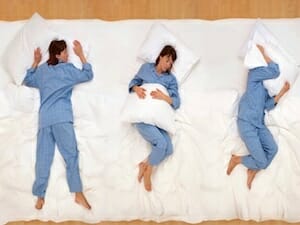
I’ve mentioned deep sleep in this (too brief) summary several times. What is it, exactly? We sleep in 90-minute cycles, and it’s only towards the end of each one of these that we go into deep sleep. Each cycle comprises two kinds of sleep. First, there is NREM sleep (non-rapid eye movement sleep); this is then followed by REM (rapid eye movement) sleep. When Walker talks about these cycles, which still have their mysteries, his voice changes. He sounds bewitched, almost dazed.
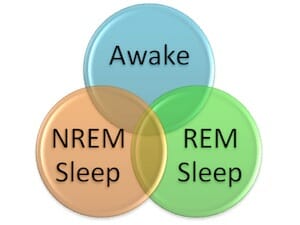
“During NREM sleep, your brain goes into this incredible synchronised pattern of rhythmic chanting,” he says. “There’s a remarkable unity across the surface of the brain, like a deep, slow mantra. Researchers were once fooled that this state was similar to a coma. But nothing could be further from the truth. Vast amounts of memory processing is going on. To produce these brainwaves, hundreds of thousands of cells all sing together, and then go silent, and on and on. Meanwhile, your body settles into this lovely low state of energy, the best blood-pressure medicine you could ever hope for. REM sleep, on the other hand, is sometimes known as paradoxical sleep, because the brain patterns are identical to when you’re awake. It’s an incredibly active brain state. Your heart and nervous system go through spurts of activity: we’re still not exactly sure why.”
Does the 90-minute cycle mean that so-called power naps are worthless? “They can take the edge off basic sleepiness. But you need 90 minutes to get to deep sleep, and one cycle isn’t enough to do all the work. You need four or five cycles to get all the benefit.” Is it possible to have too much sleep? This is unclear. “There is no good evidence at the moment. But I do think 14 hours is too much. Too much water can kill you, and too much food, and I think ultimately the same will prove to be true for sleep.” How is it possible to tell if a person is sleep-deprived? Walker thinks we should trust our instincts. Those who would sleep on if their alarm clock was turned off are simply not getting enough. Ditto those who need caffeine in the afternoon to stay awake. “I see it all the time,” he says. “I get on a flight at 10am when people should be at peak alert, and I look around, and half of the plane has immediately fallen asleep.”
So what can the individual do? First, they should avoid pulling “all-nighters”, at their desks or on the dancefloor. After being awake for 19 hours, you’re as cognitively impaired as someone who is drunk. Second, they should start thinking about sleep as a kind of work, like going to the gym (with the key difference that it is both free and, if you’re me, enjoyable). “People use alarms to wake up,” Walker says. “So why don’t we have a bedtime alarm to tell us we’ve got half an hour, that we should start cycling down?” We should start thinking of midnight more in terms of its original meaning: as the middle of the night. Schools should consider later starts for students; such delays correlate with improved IQs. Companies should think about rewarding sleep. Productivity will rise, and motivation, creativity and even levels of honesty will be improved. Sleep can be measured using tracking devices, and some far-sighted companies in the US already give employees time off if they clock enough of it. Sleeping pills, by the way, are to be avoided. Among other things, they can have a deleterious effect on memory.
Those who are focused on so-called “clean” sleep are determined to outlaw mobiles and computers from the bedroom – and quite right, too, given the effect of LED-emitting devices on melatonin, the sleep-inducing hormone. Ultimately, though, Walker believes that technology will be sleep’s saviour. “There is going to be a revolution in the quantified self in industrial nations,” he says. “We will know everything about our bodies from one day to the next in high fidelity. That will be a seismic shift, and we will then start to develop methods by which we can amplify different components of human sleep, and do that from the bedside. Sleep will come to be seen as a preventive medicine.”
What questions does Walker still most want to answer? For a while, he is quiet. “It’s so difficult,” he says, with a sigh. “There are so many. I would still like to know where we go, psychologically and physiologically, when we dream. Dreaming is the second state of human consciousness, and we have only scratched the surface so far. But I would also like to find out when sleep emerged. I like to posit a ridiculous theory, which is: perhaps sleep did not evolve. Perhaps it was the thing from which wakefulness emerged.” He laughs. “If I could have some kind of medical Tardis and go back in time to look at that, well, I would sleep better at night.”
Sleep in numbers:
■ Two-thirds of adults in developed nations fail to obtain the nightly eight hours of sleep recommended by the World Health Organisation.
■ An adult sleeping only 6.75 hours a night would be predicted to live only to their early 60s without medical intervention.
■ A 2013 study reported that men who slept too little had a sperm count 29% lower than those who regularly get a full and restful night’s sleep.
■ If you drive a car when you have had less than five hours’ sleep, you are 4.3 times more likely to be involved in a crash. If you drive having had four hours, you are 11.5 times more likely to be involved in an accident.
■ A hot bath aids sleep not because it makes you warm, but because your dilated blood vessels radiate inner heat, and your core body temperature drops. To successfully initiate sleep, your core temperature needs to drop about 1C.
■ The time taken to reach physical exhaustion by athletes who obtain anything less than eight hours of sleep, and especially less than six hours, drops by 10-30%.
■ There are now more than 100 diagnosed sleep disorders, of which insomnia is the most common.
■ Morning types, who prefer to awake at or around dawn, make up about 40% of the population. Evening types, who prefer to go to bed late and wake up late, account for about 30%. The remaining 30% lie somewhere in between.